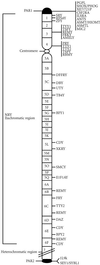The Human Y Chromosome: The Biological Role of a "Functional Wasteland"
- PMID: 12488622
- PMCID: PMC79676
- DOI: 10.1155/S1110724301000080
The Human Y Chromosome: The Biological Role of a "Functional Wasteland"
Abstract
"Functional wasteland," "Nonrecombining desert" and "Gene-poor chromosome" are only some examples of the different definitions given to the Y chromosome in the last decade. In comparison to the other chromosomes, the Y is poor in genes, being more than 50% of its sequence composed of repeated elements. Moreover, the Y genes are in continuous decay probably due to the lack of recombination of this chromosome. But the human Y chromosome, at the same time, plays a central role in human biology. The presence or absence of this chromosome determines gonadal sex. Thus, mammalian embryos with a Y chromosome develop testes, while those without it develop ovaries (Polani, 1981). What is responsible for the male phenotype is the testis-determining SRY gene (Sinclair, 1990) which remains the most distinguishing characteristic of this chromosome. In addition to SRY, the presence of other genes with important functions has been reported, including a region associated to Turner estigmata, a gene related to the development of gonadoblastoma and, most important, genes related to germ cell development and maintenance and then, related with male fertility (Lahn and Page, 1997). This paper reviews the structure and the biological functions of this peculiar chromosome.
Figures
References
-
- Polani PE. Experiments on chiasmata and nondisjunction in mice. Hum Genet Suppl. 1981;2:145–146. - PubMed
-
- Sinclair AH, Berta P, Palmer MS, et al. A gene from the human sex-determining region encodes a protein with homology to a conserved DNA-binding motif. Nature. 1990;346:240–244. - PubMed
-
- Lahn BT, Page D. Functional coherence of the human Y chromosome. Science. 1997;278:675–680. - PubMed
-
- Tiepolo L, Zuffardi O. Localization of factors controlling spermatogenesis in the nonfluorescent portion of the human Y chromosome long arm. Hum Genet. 1976;34:119–124. - PubMed
-
- Jacobs PA, Ross A. Structural abnormalities of the Y chromosome in man. Nature. 1966;210:352–354. - PubMed
LinkOut - more resources
Full Text Sources


